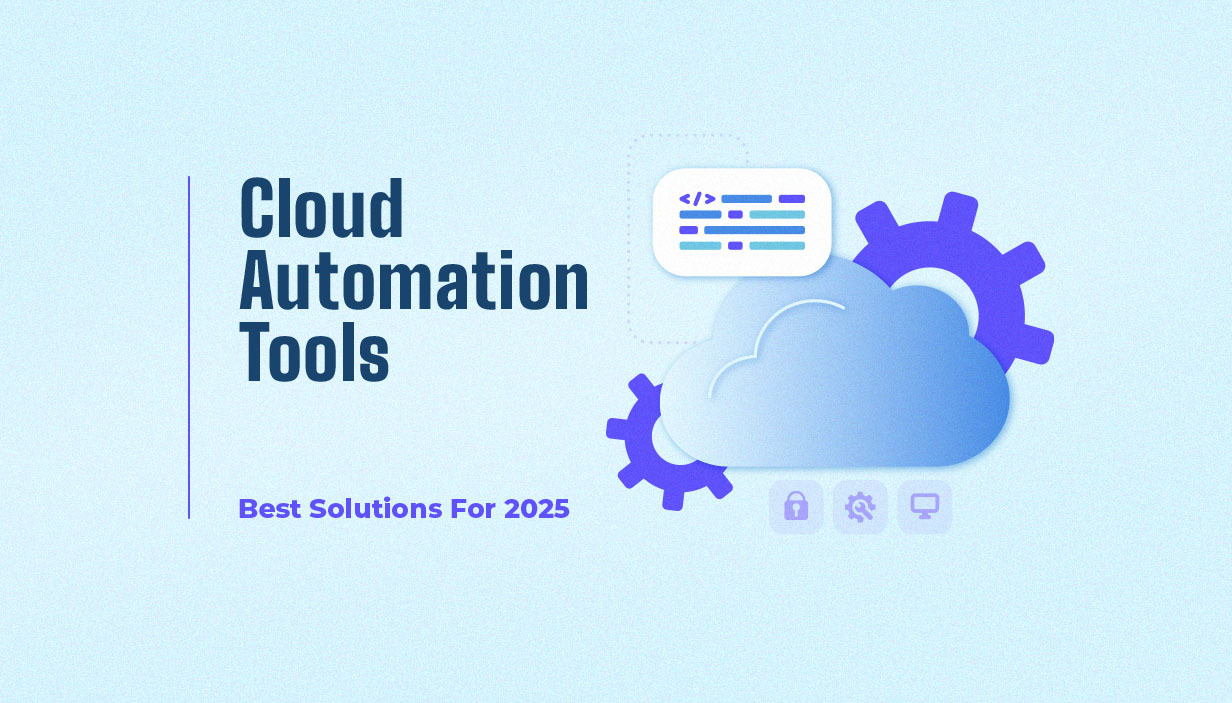Cloud automation is transforming the way organizations manage, deploy, and optimize their IT infrastructure. By automating repetitive tasks, businesses can accelerate innovation, reduce errors, and maximize efficiency in the cloud. Cloud infrastructure automation tools automate various aspects of cloud management, such as provisioning, configuration, monitoring, and security. In this guide, we’ll explore what cloud automation is, how to choose the right tool, and review the 22 best cloud automation tools for 2025.
What is Cloud Automation?
Cloud automation refers to the use of software tools and processes to automatically manage cloud resources, such as provisioning servers, configuring networks, enforcing compliance, and optimizing costs. The goal is to reduce manual intervention, ensuring consistency and speed across cloud environments. Cloud automation can be applied to both public and private cloud environments, with major cloud providers such as AWS, Microsoft Azure, and Google Cloud offering automation capabilities.
Cloud Automation vs Orchestration
While both concepts are related, automation typically focuses on individual tasks (like deploying a server), whereas orchestration coordinates multiple automated tasks into cohesive workflows, such as spinning up an entire application stack.
Key Benefits of Cloud Automation
- Efficiency: Reduces manual effort and operational overhead.
- Consistency: Minimizes configuration drift and human error.
- Scalability: Enables rapid scaling to meet demand.
- Cost savings: Optimizes resource usage and spending.
- Compliance: Enforces policies automatically across environments.
Types of Cloud Automation Tools
Cloud automation tools fall into several key categories, each designed to simplify and streamline different aspects of cloud management:
- Infrastructure as Code (IaC) Tools: IaC tools like AWS CloudFormation and Azure Automation allow users to define infrastructure using high-level configuration files. This approach makes it easy to provision, manage, and scale resources while ensuring consistency across environments.
- Configuration Management Tools: Tools such as CFEngine and Ansible help maintain consistency across systems by ensuring that infrastructure remains in the desired state. These tools are widely used for their ability to automate complex configuration tasks, enforce policies, and support code reuse across multiple setups.
- Workflow Automation Tools: Workflow automation platforms like Zapier and Automate.io enable users to automate intricate workflows and integrate a variety of tools and services.
Many of these tools offer extensive documentation and a wide range of plugins, making it easier for teams to get started and tailor solutions to their specific needs. For example, Python is a popular language for automation, and many tools provide Python libraries or plugins to further simplify automation tasks.
When choosing a cloud automation tool, consider factors such as scalability, integration capabilities, and reliability to ensure the solution aligns with your organization’s unique requirements.
How to Choose the Right Cloud Automation Tool
Selecting the best tool depends on factors like your cloud provider, existing workflows, compliance requirements, team expertise, and integration needs. Consider whether you need infrastructure as code, configuration management, monitoring, or a combination. For a deeper dive, see our guide on cloud infrastructure management.

Eliminate unnecessary resources, & enhance fault tolerance with enterprise-grade tools.
Cloud Automation for DevOps
Cloud automation is a cornerstone of modern DevOps practices, empowering teams to automate repetitive tasks and focus on innovation and growth. By adopting cloud automation, DevOps teams can:
- Improve System Performance: Automation enables real-time monitoring and alerting, allowing teams to quickly respond to events and prevent downtime. For instance, integrating tools like New Relic provides comprehensive visibility into system performance and health.
- Increase Efficiency: Automating deployment tasks and workflows reduces manual intervention, streamlines processes, and accelerates application development.
- Enhance Reliability: Automated alerting and event-driven responses help maintain business continuity and minimize disruptions.
Many cloud automation tools offer a free tier or trial period, giving teams the opportunity to test features and ensure the tool is suitable for their needs before making a commitment. When implementing DevOps automation, prioritize tools that support code reuse, offer versatile integration options, and are easy to set up and scale as your requirements evolve.
Cloud Security Automation
Cloud security automation is essential for protecting cloud infrastructure and ensuring business continuity. By automating security tasks, organizations can:
- Prevent Downtime and Ensure Compliance: Automated processes for encryption, access management, and compliance monitoring help maintain a secure environment and reduce the risk of human error.
- Streamline Access Management: For example, AWS offers tools like AWS CloudHSM and AWS IAM to automate encryption and manage user access, while Azure provides Azure Security Center and Azure Active Directory for similar purposes.
- Support Business Continuity: Automated security workflows help organizations respond quickly to threats and maintain consistent security policies across cloud and on-premises data centers.
When choosing a cloud security automation tool, consider your organization’s specific needs for scalability, reliability, and compliance. The right solution will help you automate critical security tasks, reduce manual workload, and maintain a robust security posture.
Cloud Cost Optimization
Optimizing cloud costs is a top priority for organizations looking to maximize efficiency and reduce unnecessary spending. Cloud automation tools play a vital role in:
- Automating Resource Management: Automatically scaling instances and managing resources ensures you only pay for what you need, when you need it.
- Monitoring and Controlling Costs: Tools like AWS Cost Explorer and AWS Trusted Advisor provide actionable insights to help optimize spending, while Azure Cost Estimator and Azure Advisor offer similar capabilities for Azure environments.
- Supporting Growth: Automated cost optimization allows organizations to scale cloud usage efficiently without overspending.
When choosing a cloud cost optimization tool, focus on solutions that offer scalability, reliability, and ease of use. The right tool will adapt to your organization’s evolving needs, simplify resource management, and help you achieve cost savings as your cloud infrastructure grows.
22 Best Cloud Automation Tools for 2025
1. CTO2B
CTO2B stands out as an all-in-one automation platform designed for modern cloud infrastructure management. It streamlines everything from provisioning and compliance to cost control, making it a robust choice for enterprises seeking end-to-end automation. With CTO2B, organizations can centralize their cloud infrastructure management, automate complex DevOps automation workflows, and ensure continuous cloud compliance with built-in policy enforcement. The platform also offers real-time cloud cost optimization features to help teams monitor and reduce spending, and supports seamless cloud migration for businesses transitioning to or between cloud environments. CTO2B integrates easily with existing CI/CD pipelines, providing a unified dashboard for multi-cloud visibility and hybrid environments.
Key Features:
- Centralized dashboard for multi-cloud management
- Automated policy enforcement and compliance tracking
- Real-time cost optimization and monitoring
- Integration with CI/CD pipelines
- Supports cloud migration and hybrid environments
Pros:
- Unified platform with comprehensive features
- User-friendly interface
- Strong support for compliance and cost management
Cons:
- Enterprise focus may be more than needed for small teams
- Requires initial setup and onboarding
Explore more about CTO2B’s capabilities in cloud infrastructure management, DevOps automation, cloud compliance, cloud cost optimization, and cloud migration.
2. Terraform
Terraform is a leading infrastructure as code tool that lets you define and provision cloud resources using simple configuration files.
Key Features:
- Cloud-agnostic support
- Modular and reusable code
- State management and collaboration
Pros:
- Large community and provider ecosystem
- Supports multi-cloud deployments
Cons:
- State file management can be complex
- Steeper learning curve for large projects
3. Ansible
Ansible simplifies automation with agentless architecture and human-readable YAML playbooks.
Key Features:
- Agentless operation
- Idempotent task execution
- Wide module support
Pros:
- Easy to start and scale
- Strong community
Cons:
- Can be slower for large infrastructures
- Less suited for complex workflows
4. AWS CloudFormation
AWS CloudFormation is Amazon’s native IaC offering for automating AWS resource management.
Key Features:
- JSON/YAML templates
- StackSets for multi-account/region
- Drift detection and rollback
Pros:
- Deep AWS integration
- Secure and reliable
Cons:
- AWS-only
- Complex templates for large projects
5. Google Cloud Deployment Manager
A GCP-native tool for automating resource provisioning with declarative templates.
Key Features:
- YAML/Python templates
- Automated dependency management
- Integration with GCP services
Pros:
- Native GCP support
- Easy repeatable deployments
Cons:
- GCP-only
- Smaller community than some competitors
6. Azure Automation
Azure Automation automates process, configuration, and update management for Azure environments.
Key Features:
- Runbooks for task automation
- Update management
- Hybrid cloud support
Pros:
- Comprehensive Azure integration
- Scalable and secure
Cons:
- Azure-centric
- UI can be complex for beginners
7. Pulumi
Pulumi enables infrastructure as code using languages like Python, Go, and C#.
Key Features:
- Multi-language support
- Multi-cloud deployments
- State management
Pros:
- Familiar programming languages
- Flexible and extensible
Cons:
- Smaller community than Terraform
- Requires language-specific expertise
8. OpenTofu
OpenTofu is a community-driven, open-source alternative to Terraform.
Key Features:
- Terraform compatibility
- State encryption
- Modular design
Pros:
- No vendor lock-in
- Compatible with Terraform modules
Cons:
- Newer, less mature ecosystem
- Documentation still growing
9. Chef
Chef automates infrastructure configuration using a Ruby-based DSL.
Key Features:
- Cookbooks and recipes
- Test-driven infrastructure
- Cross-platform support
Pros:
- Flexible and procedural
- Good for complex workflows
Cons:
- Steep learning curve
- Requires Ruby knowledge
10. Puppet
Puppet is a declarative configuration management tool for automating server setups.
Key Features:
- Role-based access control
- Compliance and reporting
- Supports hybrid/multi-cloud
Pros:
- Mature and scalable
- Extensive module library
Cons:
- Complex initial setup
- Agent/server overhead
11. Spacelift
Spacelift unifies infrastructure as code workflows across multiple tools and clouds.
Key Features:
- Centralized IaC management
- Policy enforcement
- Drift detection
Pros:
- Supports multiple IaC tools
- Strong governance features
Cons:
- Commercial pricing
- Learning curve for advanced features
12. Jenkins
Jenkins is a popular open-source automation server for continuous integration and delivery.
Key Features:
- Pipeline as code
- Large plugin ecosystem
- Multi-platform support
Pros:
- Highly customizable
- Broad community support
Cons:
- Requires ongoing maintenance
- Can become complex at scale
13. CircleCI
CircleCI is a cloud-based CI/CD platform with easy pipeline configuration.
Key Features:
- YAML-based pipelines
- Parallelism and caching
- VCS integration
Pros:
- Fast setup
- Scalable and flexible
Cons:
- Usage-based pricing
- Less control than self-hosted options
14. Datadog
Datadog provides unified monitoring and observability for cloud environments.
Key Features:
- Real-time metrics, logs, traces
- 600+ integrations
- Custom dashboards
Pros:
- Easy integration
- Powerful visualization tools
Cons:
- Can get expensive with scale
- Advanced features have a learning curve
15. Amazon CloudWatch
Amazon CloudWatch is AWS’s native monitoring and observability service.
Key Features:
- Metrics, logs, alarms
- Automated responses
- Container insights
Pros:
- Deep AWS integration
- Automated scaling and alerting
Cons:
- AWS-only
- Limited hybrid support
16. New Relic
New Relic delivers full-stack observability and real-time analytics.
Key Features:
- Telemetry for apps and infrastructure
- AI-driven anomaly detection
- Custom dashboards
Pros:
- Supports many environments
- Strong analytics
Cons:
- Cost increases with scale
- Complex configuration for large setups
17. Rudder
Rudder is a compliance-focused configuration management tool.
Key Features:
- Declarative management
- Real-time compliance reporting
- Web UI and API
Pros:
- Strong compliance focus
- Scalable for large fleets
Cons:
- Smaller community
- UI can feel dated
18. SaltStack
SaltStack is a high-speed configuration management and orchestration tool.
Key Features:
- Master-minion or agentless modes
- Event-driven automation
- Modular, Python/YAML-based
Pros:
- Fast and scalable
- Flexible architecture
Cons:
- Complex for new users
- Fragmented documentation
19. AppDynamics
AppDynamics offers application performance monitoring and analytics.
Key Features:
- Real-time analytics
- Business transaction tracking
- Cloud and on-prem support
Pros:
- Deep application insights
- Strong diagnostics
Cons:
- Premium pricing
- Can be complex to configure
20. Prisma Cloud
Prisma Cloud provides comprehensive cloud security and compliance.
Key Features:
- Security posture management
- Vulnerability scanning
- Compliance enforcement
Pros:
- Multi-cloud security
- Continuous compliance
Cons:
- Enterprise focus
- Some features are cloud-specific
21. Orca Security
Orca Security delivers agentless, context-aware cloud security.
Key Features:
- Continuous monitoring
- Risk prioritization
- Compliance mapping
Pros:
- Easy deployment
- Unified risk dashboard
Cons:
- Premium pricing
- Evolving feature set
22. Commvault
Commvault is an enterprise-grade data protection and disaster recovery platform.
Key Features:
- Automated backup and recovery
- Ransomware protection
- Centralized management
Pros:
- Comprehensive data protection
- Automated compliance
Cons:
- Complex setup
- Costly for small teams
Key Features to Look For in Cloud Automation Tools
- Multi-cloud and hybrid support
- Integration with CI/CD and DevOps automation
- Real-time monitoring and alerting
- Automated compliance enforcement
- Cost optimization and resource scheduling
Common Use Cases for Cloud Automation Tools
- Infrastructure provisioning and scaling
- Automated compliance enforcement
- Continuous integration and delivery
- Monitoring and alerting
- Resource cleanup and cloud migration
Challenges When Implementing Cloud Automation
- Complexity of integration with legacy systems
- Ensuring security and compliance
- Managing costs as automation scales
- Training teams on new tools and processes
FAQs
What is cloud automation?
Cloud automation uses tools and scripts to automatically provision, configure, and manage cloud resources, reducing manual work and increasing consistency.
What are examples of cloud automation tools?
Popular examples include Terraform, Ansible, CTO2B, AWS CloudFormation, and Jenkins.
What are the types of cloud automation?
Types include infrastructure automation, configuration automation, deployment automation, and scaling/optimization automation.
What is the difference between cloud automation and orchestration?
Automation handles individual tasks, while orchestration coordinates multiple automated tasks into workflows.
What are the benefits of cloud automation tools?
Key benefits include efficiency, consistency, scalability, cost savings, and improved compliance.
How do I choose the best cloud automation tool for my organization?
Assess your environment, feature requirements, compliance needs, and integration capabilities before selecting a tool.
What are the challenges in implementing cloud automation?
Common challenges include integration complexity, security, cost management, and team training.
Is Kubernetes a cloud automation tool?
Kubernetes is a container orchestration platform, often used alongside automation tools for managing containerized workloads.
Can cloud automation improve security and compliance?
Yes, by enforcing policies automatically and providing audit trails, automation tools help maintain security and compliance.

